- Home
- SHOP ECO FARM
-
TOP BRANDS
-
Grow Lights Brands
- Adjust-A-Wing
- Apollo Horticulture
- Bestva
- Black Dog LED
- California Lightworks
- ChilLED Grow Light
- Eco Farm
- HLG - Horticulture Lighting Group
- Kingled
- Kind LED
- Mars Hydro
- Morsen
- Neilo
- NextLight
- Phlizon
- PlatinumLed
- Roleadro
- Optic LED Grow Lights
- ViparSpectra
- Vivosun
- EYE Hortilux
- IPOWER
- NanoLux
- Phantom grow light
- Gavita grow lights
- Grower's Choice
- Lumatek
- Maxibright
- Yearld Pro
- ThinkGrow
- Crecer Lighting
- Green Sunshine Electric Sky
- fohse aries
- loriflux
- luxx
- fluence
- iluminar
- Lex
- LTC
- Rayonled
- FGI
- PHOTONTEK
- Grow Tents & Kits Brands
- Extraction & Harvest Brands
- Climate Control & Hydroponic Brands
-
Grow Lights Brands
- COMPANY INFO
- COOPERATE WITH US
- Blog
- Sign in
- Home
-
SHOP ECO FARM
- ECO Farm Grow Lights
- ECO Farm LED Grow Lights
- ECO Farm Quantum Board
- ECO Farm Samsung LED Grow Lights
- ECO Farm COB Grow Lights
- ECO Farm Commercial Lights
- ECO Farm Supplemental Grow Light
- ECO Farm Fluorescent grow lights
- ECO Farm HPS & MH Grow Lights
- ECO Farm CMH Grow Lights
- ECO Farm HID/CMH Bulbs & Ballasts
- ECO Farm Grow Tents & Kits
- ECO Farm 2x2ft Grow Kits
- ECO Farm 3x3ft Grow Kits
- ECO Farm 3.3x3.3ft Grow Kits
- ECO Farm 4x4ft Grow Kits
- ECO Farm 5x5ft Grow Kits
- ECO Farm Grow Tent - Standard Style
- ECO Farm Grow Tent - Extension & Roof & Lodge Style
- ECO Farm Extraction & Harvest
- ECO Farm Rosin Press Machine
- ECO Farm Dry & Wet Trimmers
- ECO Farm Oil Accessories
- ECO Farm Medicinal Plants Grinder
- ECO Farm Medicinal Plants Containers
- ECO Farm Medicinal Plants Dryer
- ECO Farm Refrigeration Dryer
- ECO Farm Climate Control & Other Accessories
- ECO Farm Inline Duct Fans
- ECO Farm Oscillating Fans
- ECO Farm Exhaust Fans
- ECO Farm Air Filter
- ECO Farm Duct Muffler
- ECO Farm Ventilation Kits
- ECO Farm Plant Humidifiers
- ECO Farm Plant Dehumidifiers
- ECO Farm Hydroponic Accessories
- ECO Farm Other Accessories
- ECO Farm Hydroponics Microscopes
-
TOP BRANDS
- Grow Lights Brands
- Adjust-A-Wing
- Apollo Horticulture
- Bestva
- Black Dog LED
- California Lightworks
- ChilLED Grow Light
- Eco Farm
- HLG - Horticulture Lighting Group
- Kingled
- Kind LED
- Mars Hydro
- Morsen
- Neilo
- NextLight
- Phlizon
- PlatinumLed
- Roleadro
- Optic LED Grow Lights
- ViparSpectra
- Vivosun
- EYE Hortilux
- IPOWER
- NanoLux
- Phantom grow light
- Gavita grow lights
- Grower's Choice
- Lumatek
- Maxibright
- Yearld Pro
- ThinkGrow
- Crecer Lighting
- Green Sunshine Electric Sky
- fohse aries
- loriflux
- luxx
- fluence
- iluminar
- Lex
- LTC
- Rayonled
- FGI
- PHOTONTEK
- Grow Tents & Kits Brands
- Apollo Horticulture
- Black Box
- CoolGrows
- Eco Farm
- GrowLab
- Gorilla Grow Tents
- Mars Hydro
- Quictent
- Secret Jardin
- Unit Farm
- TopoGrow
- VIVOSUN
- Topolite
-
COMPANY INFO
-
COOPERATE WITH US
- Blog
HLG Greenhouse Pro HE HV 630W LED Grow Light VS Geeklight grow light 480W hydroponic led grow light
October 20, 2023
During these shorter winter months, with less light coming through your windows, you may be wondering if your plants are getting what they need to grow. While lower light this season may be enough for some houseplants, other houseplants will need increased light to keep growing. There are also some plants, such as garden seedlings and flowering plants, that may require stronger light than your home provides.
If you’re considering introducing artificial light into your home, here’s what you need to know.
How much light do houseplants need?
Given that there are so many plants available, there’s no single answer to this question. However, there are some general rules of thumb to follow.
Low-light houseplants
Originating from shady or understory areas, these plants do well in north-facing windows or corners. They need little direct sunlight, surviving mainly in indirect light year round. These plants need 10–15 watts or approximately 50–250 lumens per square foot to thrive. They include:
Calathea
Pothos
Philodendron
Peace lily
Snake plant
English ivy
Medium-light houseplants
Well-suited to an east or west facing window, these plants do well with indirect light. They need 15–20 watts or approximately 250–1,000 lumens per square foot to thrive. Medium-light plants include:
Rubber plant
Fiddle leaf fig
Asparagus fern
Spider plant
Jade
Peperomia
High-light houseplants
Growing in direct sunlight when in nature, high-light plants do well in south or southwest-facing windows. They need more than 20 watts or more than 1,000 lumens per square foot to thrive. High-light plants include:
Poinsettia
Cactus
Succulents
Jasmine
Orchid
Citrus
Hibiscus
Before purchasing a grow light, research the requirements for the plants you already own (or the plants you hope to grow). Find out what intensity of light they require, how many hours of light they need per day, and which spectrum they prefer. If your space doesn’t provide adequate light, look for a grow light to fill the gap.
HLG Greenhouse Pro HE HV 630W LED Grow Light
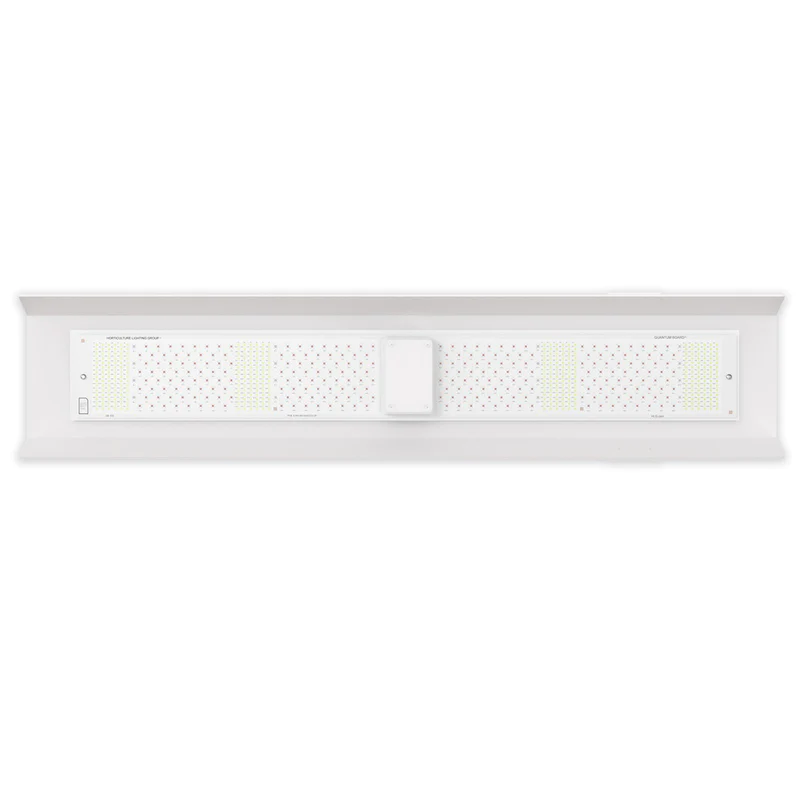
Features:
The HLG LED Grow Light is a commercial grade LED grow light designed to help growers achieve maximum yield and quality. It features high-efficiency LEDs with deep red enhancement, a slender linear design that minimizes shading of plants, and integrated reflectors that maximize photon delivery into the canopy. The HLG Greenhouse Pro HE LED grow light is also easy to install and use, and is compatible with controllers.This lamp has Full Spectrum White and Deep Red LED’s, with an efficacy of 3.4 µmol/joule.
Geeklight grow light 480W hydroponic led grow light
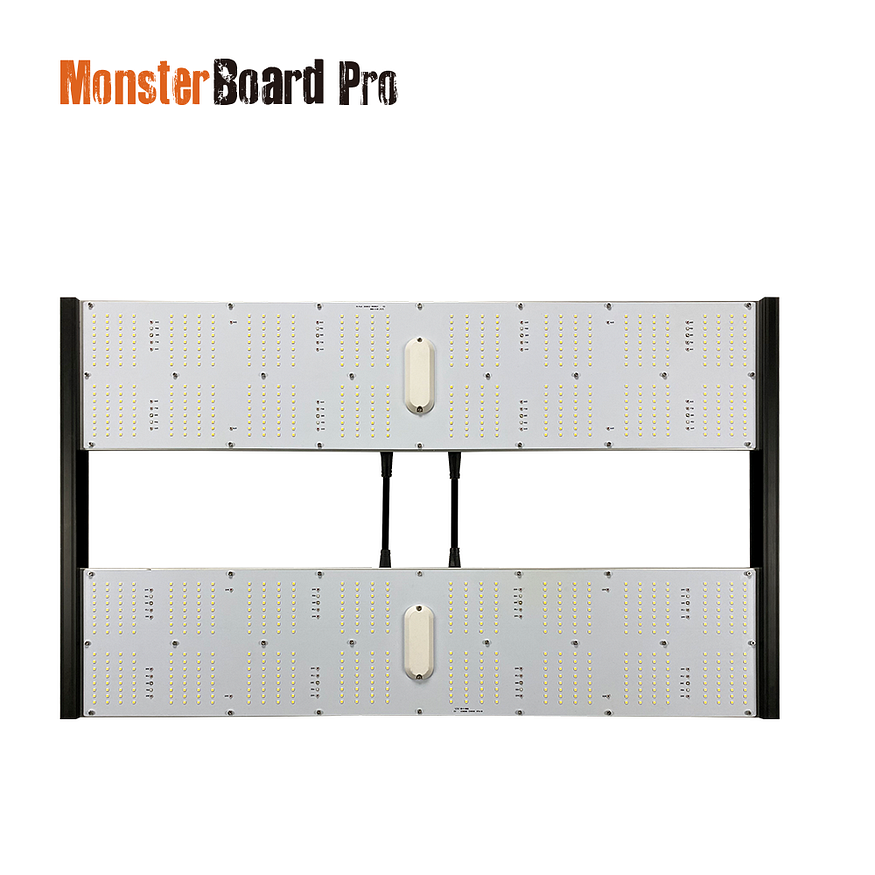
Features:
Geeklight grow light has top bin lm301h/b and UV IR smart app control. High energy efficiency of 2.75 umol/J; extremely high output, more efficient than traditional HID lamps and other plant lamps on the market. RJ12 daisy chain hydroponic led grow light. Monster board pro support to exchange from Veg to Bloom pattern, gaining higher yield in different stage; Daisy Chain function can bring you big convenience to control all lights through one light or control box; Uniform par map can Help plants grow more uniform. It has a unique appearance, through power supply and ventilation holes, no fans, low noise, and very low ambient heat, so there is no need to worry about burns or damage to plants.
Before choosing LED grow lights:
1. Understand the needs of indoor plants
Of all the factors in growing healthy houseplants, light is the most difficult to provide. 1 With the exception of a few species that prefer deep shade, most plants have adapted to receiving hours of full-spectrum bright light. sun
Full sun plants require at least 6 hours of full sun
Medium-light plants or plants that thrive in indirect light, including the most common houseplant species, need 3 or 4 hours of bright light
Most shade plants still need about 2 hours of sunlight per day
In order to best provide light for your plants, it is first important to research the unique light needs of your plants. Once you have that understanding, you can set up your space in a way that best meets those needs. If your environment doesn’t match the required light levels, it may be helpful to use a grow light, which is an important tool for indoor plant enthusiasts. LED grow lights are the most efficient type of grow light on the market today in terms of energy usage and also offer excellent versatility in terms of light intensity and color spectrum.
2. Match the size of your plants
A core component of horticulture lighting needs is plant size. Larger plants require more light and therefore require a larger grow light for proper exposure.
3. Leave appropriate spacing between lights
When setting up grow lights for indoor plants, it’s important to consider placement and spacing. A general rule of thumb is to keep at least 3.5–4 inches of space between the bulb/shade of your grow light and the leaves at the top of the plant (also called the canopy)!
To help achieve this, there are several different light fixtures available that may be most effective depending on the location of your indoor plants.
Iluminar HyperMol 720W LED Grow Light VS ECO Farm MB720 Foldable Grow Light Bar
September 22, 2023
Grow lights can help provide necessary light for indoor plants, even in the darkest rooms. They’re easy to set up and can help take your home gardening to the next level. With a little knowledge and the right equipment, you can become an expert indoor gardener in no time!
Why Use Grow Lights?
Grow lights offer numerous advantages for indoor and outdoor gardening, including:
Extended Growing Season: Grow lights make it possible to cultivate plants year-round, regardless of the weather or available sunlight.
Improved Plant Health: By providing the optimal light spectrum, grow lights ensure that plants receive the right amount of light for healthy growth, leading to stronger and more vibrant plants.
Controlled Environment: Indoor gardening with grow lights allows gardeners to create a consistent and ideal environment for plant growth, reducing the impact of pests, diseases, and fluctuating weather conditions.
Greater Plant Variety: Grow lights enable gardeners to cultivate a wider range of plants, including exotic species and varieties that may not otherwise thrive in their local climate.
Iluminar HyperMol 720W LED Grow Light
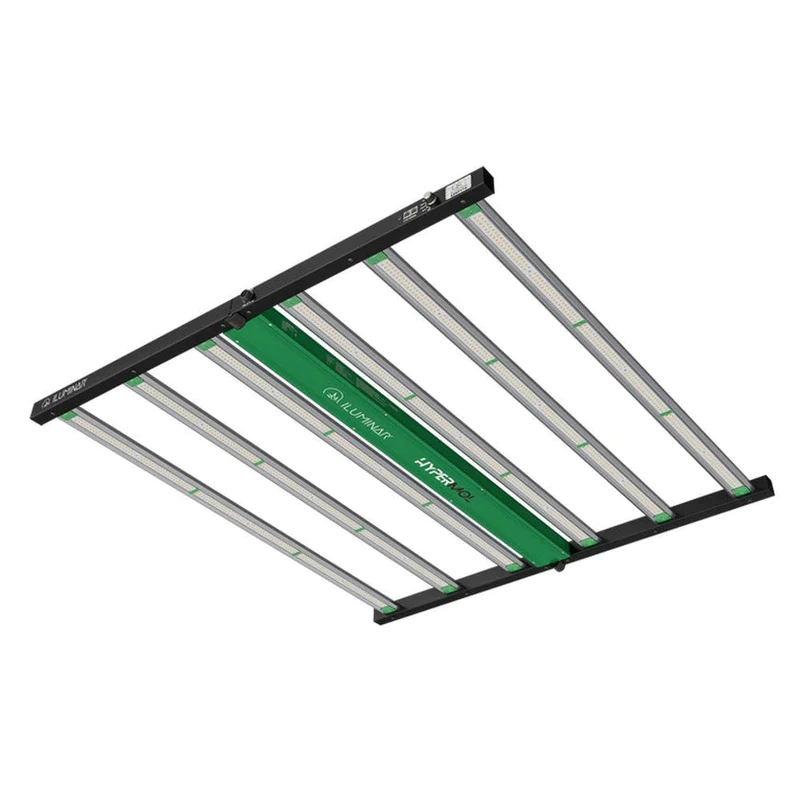
Features:
Iluminar LED Grow Light is a plug and play high performance LED grow light. Advanced SMD chips are used with non-adhesive potting to ensure longer life and better durability. The unique diode layout provides a uniform 4' x 4' footprint with a minimum of 8–12 inches from the canopy. More fins allow for quiet and efficient cooling.
ECO Farm MB720 Foldable Grow Light Bar

Features:
ECO Farm LED grow light is equipped with Samsung LM301B LED chip, using Osram 660nm chip, the light output is as high as 2.7 μmol/J, the PPF output is 1944 umol/s, the photons are completely evenly distributed in the 5×5ft coverage area, reducing energy consumption while increasing power , more efficient and energy-efficient than traditional HPS. The slim bar design shines with the latest aluminum heatsinks for better airflow and excellent cooling without noise. Patented reverse folding design, 180° perfect flat, LED waterproof coating, no fear of wet environment, built-in power supply, no messy wires.
Buying Guide
When it comes to buying LED grow lights, there are several factors you should consider to ensure that you get the best product. Here are some important features to look out for:
Wattage and Coverage Area
The wattage of your LED grow light will determine the coverage area it can effectively illuminate. A higher wattage will generally cover a larger area, but it’s important to note that wattage does not always equate to brightness. You should choose a wattage that is appropriate for the size of your grow area.
Spectrum
The spectrum of your LED grow light is also an important factor to consider. Different plants have different lighting needs, and you should choose a light that provides the appropriate spectrum for your specific plants. Some LED grow lights offer a full spectrum, while others may only provide specific wavelengths.
Durability and Lifespan
LED grow lights are an investment, and you want to make sure that you get a product that will last. Look for lights that are made with high-quality materials and have a long lifespan. You should also consider the warranty that comes with your LED grow light.
Energy Efficiency
LED grow lights are known for their energy efficiency, but some models are more efficient than others. Look for lights that have a high PAR (photosynthetically active radiation) output per watt, as this will help you save on your energy bills.
Conclusion
In the world of indoor gardening, the quality of your LED grow lights can truly determine your success or failure. With the right combination of customizable spectrum, intensity, coverage, and energy efficiency, the best LED grow lights can propel your plants to vibrant growth and bountiful harvests. The ECO Farm LED grow light is the best example of what you need to look for on your journey to becoming a master indoor gardener. Embrace the possibilities offered by top-of-the-line LED grow lights and experience the magic of nurturing plants under perfect lighting. Your indoor garden will thank you with lush beauty.
Optic LED Slim Killa 1000W Full Spectrum LED Grow Light VS ECO Farm ECOZ PRO 1000W Samsung 301H Chips LED Grow Light
August 23, 2023
Among the many plant lights, LED plant lights are one of them, and they are also one of the most used plant lights in recent years. Compared with other plant lights, LED plant lights have the advantages of less heat generation, small footprint, and low power consumption.
By gaining a deeper understanding of how LED grow lights work, you will understand how LED grow lights can have a huge positive impact on indoor plants.
There are clear data that LED plant lights have the effect of increasing production, going to market earlier, and improving water quality of crops. That’s why more and more people choose to use them.
It is well known that different types of plants require different light spectra to thrive. Even different varieties of the same plant respond differently to the spectrum.
However, the LED plant lights currently on the market are basically full-spectrum lighting. Full spectrum is simulated sunlight, suitable for all plants. The spectrum can be customized for specific plants if you need more nuanced planting.
How to Choose the Right Grow Lights for Your Garden
You can buy three different types of grow lights. all these are:
LED Grow Light
HID (High Intensity Discharge)
CFL (Compact Fluorescent Lamp)
LED Grow Lights: This type of grow light is best for expansive gardens. It can support full cycle growth and is the most energy efficient of all grow light varieties. LED bulbs produce bright to intense light, but are less prone to heat. It has a lifespan of 5 to 10 years and requires very little energy, so it’s also cost-effective!
HID: High Intensity Discharge Lamps support a complete plant growth cycle and are one of the most reliable types of grow lights in the industry. It’s affordable, but less energy efficient than LED grow lights. In fact, the HID needs to be replaced every year because it tends to overheat. Since it generates too much heat, you must install a cooling system to avoid heat trapping in your indoor garden. This can further increase your electricity bill.
CFL: CFL grow lights are versatile and easy to set up, making them perfect for beginners. These don’t require a lot of energy to work and generate very little heat. However, CFLs are best for small to medium spaces, as they produce less light. This grow light type cannot support full cycle growth, and the bulbs require more frequent replacement than HID and LED grow lights.
As you can see from the guide above, LEDs are the most efficient of all types of grow lights you can buy on the market today. An excellent choice for building medium to large indoor gardens.
Optic LED Slim Killa 1000W Full Spectrum LED Grow Light
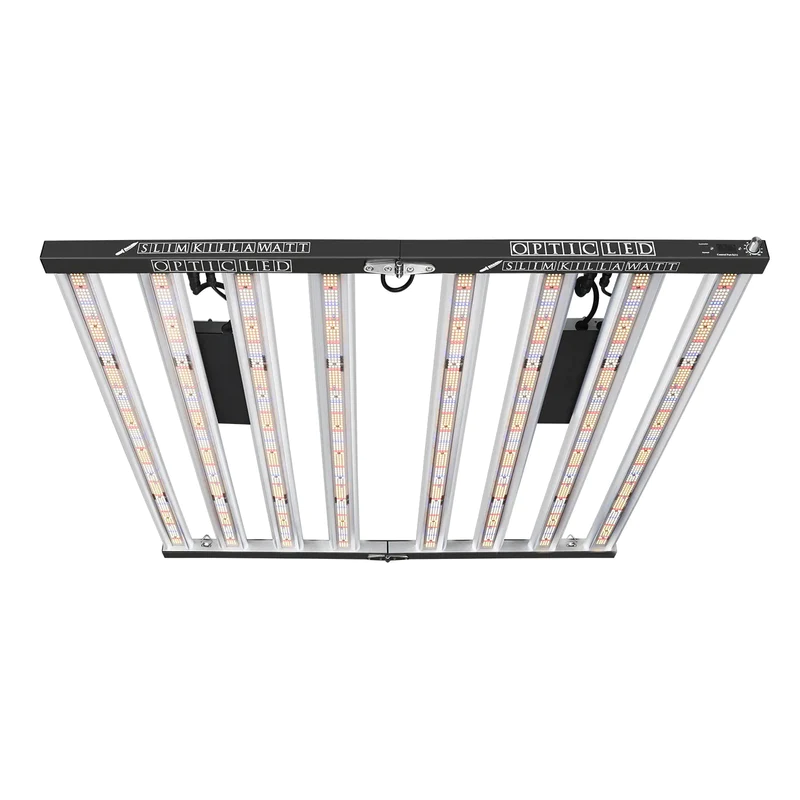
Features:
The Optic LED Grow Light is designed to hang 12 inches from the canopy and deliver up to 1000 watts, beating out more traditional 1500 watt HPS grow lights. To meet the lighting needs of plants, the Slim Killa uses a combination of Samsung LM281B+ 3500K mixed white, deep red, royal blue, infrared and ultraviolet LEDs to cover the entire growth process of plants from inception to harvest. The Slim Killa’s built-in dimmer allows you to adjust the brightness from 0–100%. The Slim Killa also uses passive cooling to keep your grow tent from being cluttered with fans.
ECO Farm ECOZ PRO 1000W Samsung 301H Chips LED Grow Light
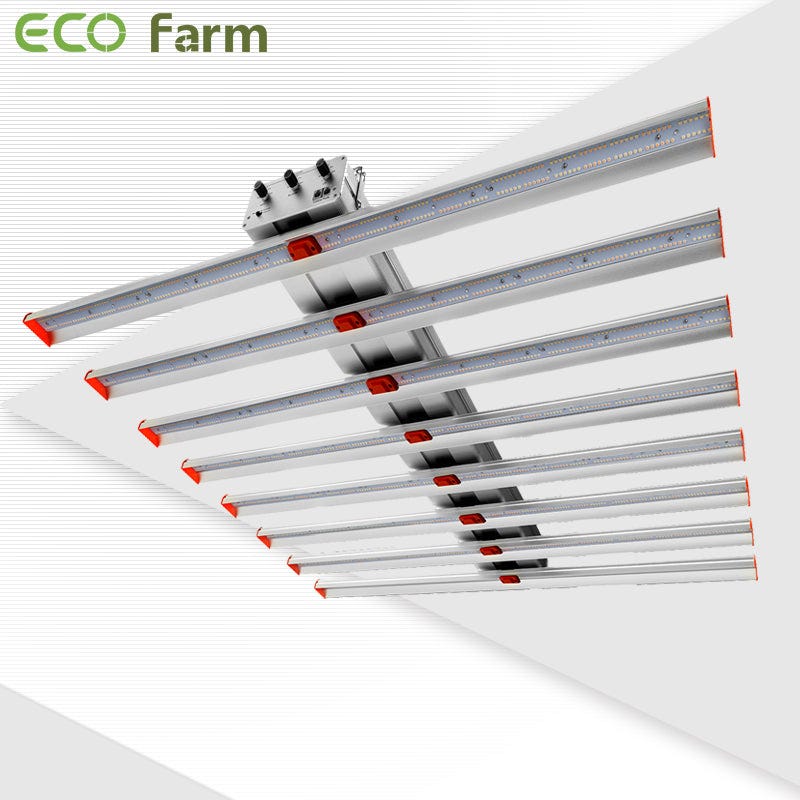
Features:
This ECO Farm LED Grow Light adopts 3480 diodes, high energy efficiency driver, a photon efficiency of 2.9 umol/J, and actual power of 1000W, providing a sufficient light source for plant growth. It’s perfect for a 7 x 7-foot plant area or a 6 x 6-foot flowering area. Composed of 660nm red light, IR, 3000K and 5000K white spectrum, this LED grow light provides everything plants need in natural sunlight at all stages from vegetable to flowering. It has a daisy chain feature that allows you to connect up to 100 lights. You only need to operate one controller (not included) to dim multiple lights at the same time, which is a great convenience for large commercial growers. The 8-bar light design and the aluminium on the back contribute to better airflow and good heat dissipation while ensuring the long life of the lights. Quiet fanless design.
Indoor Garden Grow Lights Buyer’s Guide
Durability and Warranty: Consider the build quality and longevity of your grow lights. Look for lights made from high-quality materials that can withstand everyday use. Plus, check for a solid warranty for peace of mind.
Noise level: Some grow lights can be noisy, especially those with cooling fans. If working or sleeping near an indoor garden, consider quieter options or lights with noise-canceling features.
EASY TO INSTALL: Look for grow lights that are easy to set up and install. Lights with simple plug-and-play designs or clear instructions will save you time and hassle.
Budget: Work out your budget and find the best value for money grow lights. Consider long-term benefits and energy savings when making your decision.
Conclusion
That’s all you need to know about growing plants with lights right now.
I recommend that you start experimenting with grow lights as soon as possible.
Gardening, whether it’s outdoors or indoors, takes practice, and now that you have all the information you need, it’s time to start growing your plants.
Don’t forget to share your thoughts and questions in the comments below!
Iluminar HyperMol 720W LED Grow LightVS Spectrum King Phoenix 680W LED Grow Light
June 27, 2023
LED grow lights are a popular choice for indoor growers due to their energy efficiency, ease of use, and ability to produce high-quality plants. LED lights can provide the correct light spectrum that plants need to grow optimally and help growers achieve higher yields and better quality buds. In this article, we’ll explore the benefits of LED lights for growing plants indoors and provide some advice to help you choose the best LED grow lights for your needs.
Why LED Lights Are Better Than Other Types
In short, different LED grow lights emit different types of light.
For most small, nutritious plants grown indoors, LED lights are often the grow light of choice because the bright white LED lights cover the blue region of the color spectrum, which is what these plants need. As they mature, LED lights can provide the red and yellow illumination that plants require. They can also provide green lighting benefits. LED lights help plants process organics efficiently. This improves the quality of the harvest, especially compared to other types of light.
Iluminar HyperMol 720W LED Grow Light
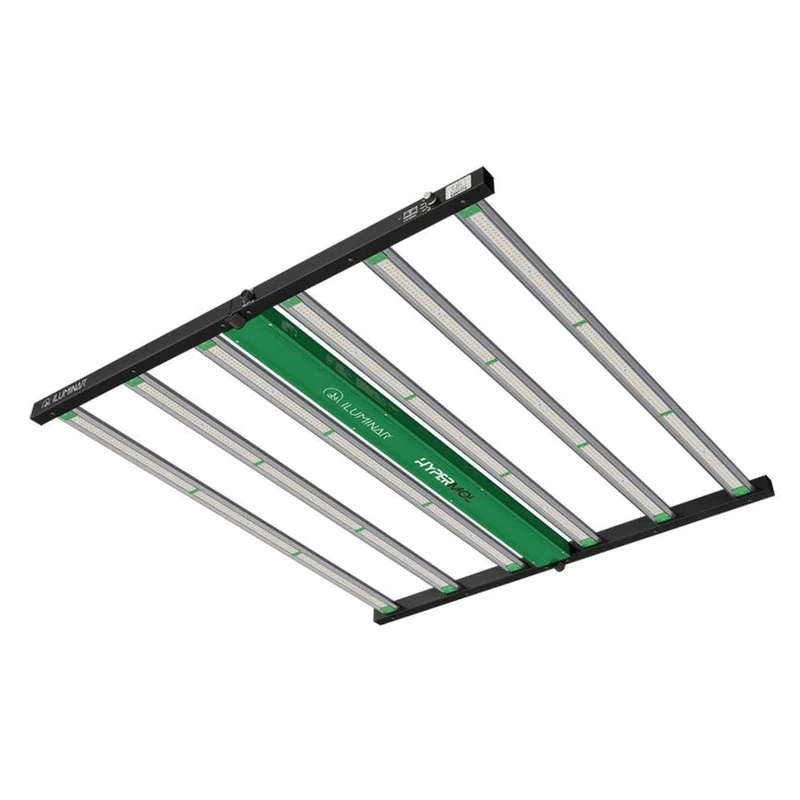
Features:
Iluminar LED Grow Light is a plug and play high performance LED grow light. Advanced SMD chips are used with non-adhesive potting to ensure longer life and better durability. The unique diode layout provides a uniform 4' x 4' footprint with a minimum of 8–12 inches from the canopy. More fins allow for quiet and efficient cooling.
Spectrum King Phoenix 680W LED Grow Light
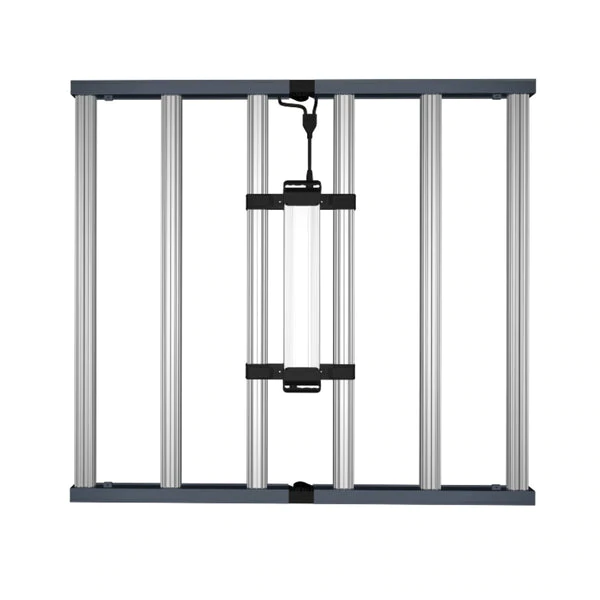
Features:
The Spectrum King LED grow light is the new LED standard for a 1:1 1000W DE HPS replacement that consumes 36% less power while offering the highest reliability in the industry. SK Cryo-Therm cooling technology enables an ultra-thin profile that maximizes airflow and minimizes microclimates. This grow light is optimized for single or multi-level planting close to the canopy.
Things to consider
Grow Light Placement and Coverage
The distance between the grow lights and the plants and the size of the area covered by the lights are key factors in the success of indoor gardening. Make sure the grow lights are at the proper distance from the plants and that the light is evenly distributed to avoid uneven growth or light burn. Also, make sure your grow lights provide adequate coverage for the entire plant canopy.
Grow Light Energy Efficiency and Thermal Management
Energy efficiency is an important consideration when choosing grow lights, as it directly affects your electricity bills and the overall sustainability of your garden. LED grow lights are usually the most energy efficient option, followed by CMH and fluorescent lights. Additionally, managing the heat generated by grow lights is critical to preventing plant damage and maintaining optimal growing conditions. Proper ventilation and cooling systems may be necessary, especially with high wattage grow lights.
Cost and Maintenance of Running Grow Lights
The price and maintenance requirements of different types and brands of grow lights vary widely. While the upfront cost of LED grow lights can be high, their long-term cost is usually low due to their energy efficiency and long lifespan. The ongoing cost of bulb replacement and maintenance must be considered when choosing a grow light system.
Plant Specific Considerations
Different plants have unique light needs, and it’s important to research the specific needs of the plants you plan to grow. Some plants may require higher light intensities, a specific spectrum, or a specific amount of light to thrive. Tailor grow light settings to the specific needs of your plants for best results.
By considering these other aspects of grow lights, you can make more informed decisions about your indoor gardening setup and create a thriving environment for your plants. The key to success is understanding the unique needs of your plants and choosing the right grow lighting system to support their growth and development.
Spectrum of Grow Lights
Understanding the light spectrum and how it affects plant growth is critical to using grow lights effectively. Plants require different light spectra at different growth stages. Blue light promotes vegetative growth, while red light is essential for flowering and fruiting. Many grow lights offer adjustable light spectrums to meet the specific needs of plants throughout the growing cycle.
Conclusion
You don’t need to be a gardening expert to know that natural light is best for plants. That said, there are many situations where natural outdoor light is limited and a little artificial help needs to be added.
LED grow lights are a great choice for outdoor gardeners or indoor gardening enthusiasts who want to provide just the right amount of light to their plants without worrying about the cost and energy consumption of traditional grow lights.
Hyphotonflux PRO-720W Full Spectrum LED Grow Light VS ECO Farm Z8–800 Samsung LM301B LED Grow Light
June 21, 2023
Not everyone has a garden that is bathed in sunlight all year round. Whether you live in a remote, sunny location or want to grow houseplants during dreary winters, these glowing wonders are a game-changer. They are expertly crafted to replicate the sun’s rays, providing the constant light energy plants need to grow big and strong. The benefits of grow lights range from faster growth to increased yields. Let’s also not lose sight of the prospect of growing exotic species that would otherwise go extinct in less-than-ideal weather.
Types of Indoor Grow Lights
LED: These lights are energy efficient and have low heat output.
Incandescent: These lights generate more heat and use more energy.
Fluorescent lights: These lights come in many forms and produce full-spectrum light for plants.
HID (also known as High Intensity Discharge): This option does a better job of simulating natural light than other grow lights.
Hyphotonflux PRO-720W Full Spectrum LED Grow Light
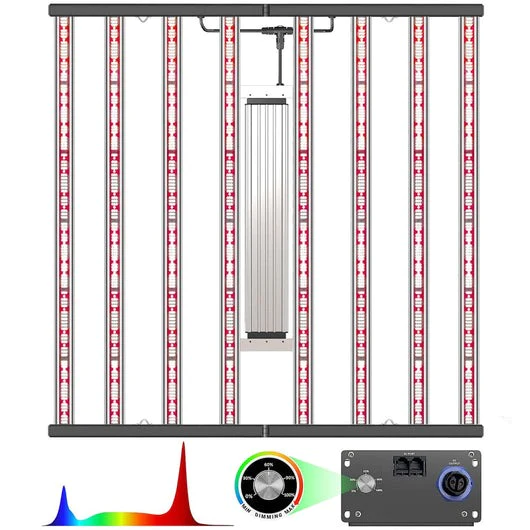
Features:
HYPHOTONFLUX LED Grow Light adopts SAMSUNG LM281B+Pro Top bin and 660nm deep red diodes (2784 in total). 720W of power delivers 2160μmol/s light output and achieves an unmatched 3.0μmol/J efficacy, completely beating 1000W HPS/MH grow lights. Full Spectrum 6500k White LED + Deep Red 660nm perfect for full cycle growth from seed to flower. Additionally, with an enhanced red spectrum, PRO-720 has better performance during flowering, making plants healthier and maximizing yield.
ECO Farm Z8–800 Samsung LM301B LED Grow Light

Features:
The ECO Farm LED grow light is equipped with SAMSUNG LM301B chip and 8 high-efficiency aluminum rods to ensure high-efficiency PPE 2.7umol/J, better heat dissipation, and long service life. Compared with old plant lights, the average PPFD is increased by 30%, and the yield and quality are increased by 50%. 8 LED growth lights, each rod is covered with high-grade glue, waterproof and easy to clean, not easy to be filled with dust. This plant growth light also uses a special dimmer, which can precisely adjust the brightness. 0–10 levels are optional. This means that you can see clear brightness levels and record while adjusting. No need to worry about differences.
Maximize Plant Growth with LED Grow Lights
How to use grow lights to maximize plant growth? Let’s find out the solution.
1. Choose the right spectrum
LED grow lights come in a variety of spectrums, each designed for a specific stage of plant growth. Understanding the different light spectra and how they affect plants is critical to maximizing growth. Blue light promotes vegetative growth and is ideal for seedlings and seedlings, while red light stimulates flowering and fruiting. Some LED grow lights even offer full-spectrum options, covering the entire range of light wavelengths needed for photosynthesis.
2. Provide sufficient light intensity
Light intensity plays a vital role in plant growth. Different plants have different light intensity requirements and it is important to provide adequate light for optimal growth. Fortunately, these lights can be adjusted to match the intensity of your houseplants. By making sure your plants get the right amount of light intensity, you can promote healthy growth, robust herbs, and abundant flowering.
3. Manage Light Duration
In addition to light intensity, the length of light time also plays a vital role in plant development. Many plants require specific photoperiods to thrive, including dark periods of rest and rejuvenation. LED grow lights can easily customize the light duration according to the requirements of the plants. Using a programmable timer, you can create a consistent light schedule that mimics the natural day-night cycle, promoting healthy growth patterns and maximizing photosynthesis.
4. Control the light direction
Another advantage of LED grow lights is their directional lighting capabilities. Unlike traditional lighting options, LED lights shine in a specific direction, minimizing light waste and ensuring that most of the light is focused on your plants. This targeted approach to lighting helps maximize light absorption and minimize shadows, resulting in greater energy efficiency and overall plant growth.
5. Space and design flexibility
LED grow lights offer versatility in terms of space and design flexibility. You’ll find them in different shapes and sizes, allowing you to choose the right option for your indoor garden or grow tent setup. LED grow lights can be mounted overhead, sideways, or even in tight spaces to provide your plants with ample lighting coverage. Its compact design and low heat emissions make it ideal for vertical gardening, grow tents, or other environments where space is limited.
Conclusion
We hope our buyers guide was helpful to you in finding the best LED grow lights for your indoor plants.
Also, we are sure you will find the best one for you, which will give you a perfect and beautiful indoor garden.
ECO Farm ECOD Samsung UV+ IR 1000W Dimmable LED Grow Light VS Optic LED Slim Killa 1000W Full Spectrum LED Grow Light
June 09, 2023
If you decide to grow useful flower and vegetable plants indoors, you must have the right environment for it to grow properly.
LED grow lights are a key element in growing plants at home. Indoor plants need limited light to grow and cannot tolerate direct sunlight.
In this competitive market, we have hundreds of options when it comes to purchasing the best LED grow lights on the market.
In this article, we review the best-selling grow lights on the market.
If you’re confused and can’t decide which grow light is best for your plants, the following list of the best LED grow lights will help you choose the right one.
Is it possible to increase your light coverage?
The area covered by the light is the area of the canopy that is illuminated by the beam. This is what the relationship between the intensity of the LED grow light and its coverage area requires. The farther away the light source is, the less coverage the plant will have.
Let’s say at a distance of one foot, you have a light hanging from your canopy. Then increase the clearance between the suspension height and the ground to 2 feet. As a result, the light intensity will be reduced by a quarter. This is why it is necessary to purchase insurance. The larger your footprint, the more space there will be between your lights and the canopy. However, the less light intensity the better.
ECO Farm ECOD Samsung UV+ IR 1000W Dimmable LED Grow Light

Features:
The ECO Farm LED Grow Light is powered by Samsung Full Spectrum LEDs that drive a wide spectrum from 395nm to 730nm and produce 144597 Lumens. The full spectrum coverage gives better results. Available in 3000K and 6500K. Full-spectrum light with higher intensity in the 395–730nm spectrum has been shown to perform better than the targeted spectrum for general use. The ECO Farm Samsung LED grow light produces a 1000W PPF output of 2524.5μmol/s and a PAR efficacy of 2.8umol/J making this fixture incredibly efficient compared to other commercial fixtures. LEDs generate far less heat than HPS and other HID lamps making them perfect for horticulture.
Optic LED Slim Killa 1000W Full Spectrum LED Grow Light
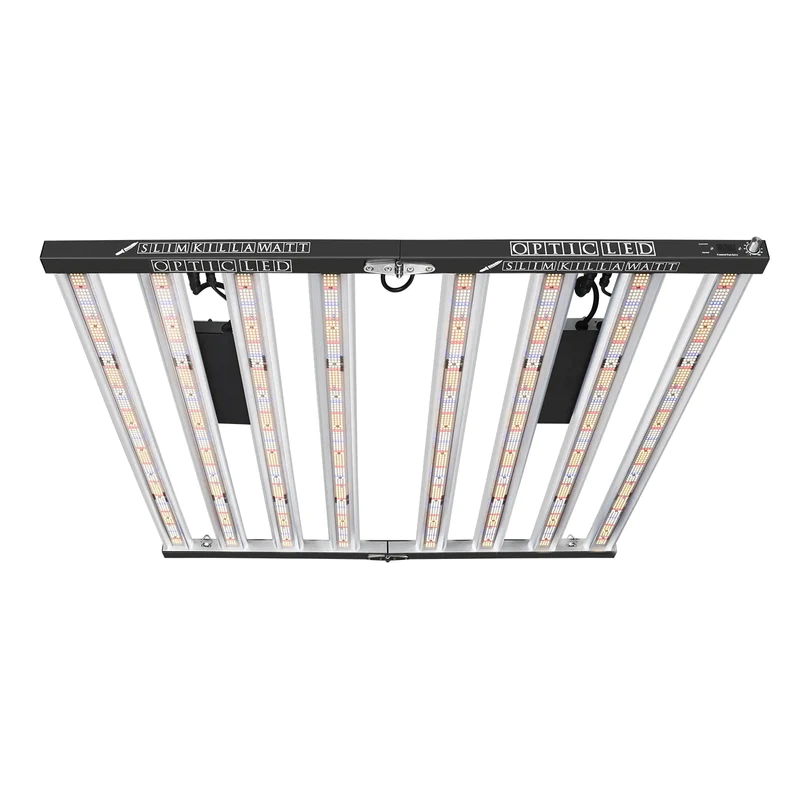
Features:
The Optic LED Grow Light is designed to hang 12 inches from the canopy and deliver up to 1000 watts, beating out more traditional 1500 watt HPS grow lights. To meet the lighting needs of plants, the Slim Killa uses a combination of Samsung LM281B+ 3500K mixed white, deep red, royal blue, infrared and ultraviolet LEDs to cover the entire growth process of plants from inception to harvest. The Slim Killa’s built-in dimmer allows you to adjust the brightness from 0–100%. The Slim Killa also uses passive cooling to keep your grow tent from being cluttered with fans.
Things to Consider
Light Output
Some LED grow light manufacturers may publish inaccurate PPF and PAR ratings, affecting how plants respond to light. In some cases, grow lights are only given a PAR rating, which is simply a measurement in the middle of the grow light’s footprint. Unfortunately, this does not represent the entire grow light, as you also need to consider the surrounding area.
In addition to buying from a reputable brand, it’s a good idea to consider looking at the reports of the independent labs that tested these grow lights. Typically, these tests are posted on the LED grow light’s product page. You can use this as a guide to check the accuracy of the information posted on the product page.
You can calculate the average PPFD for your grow lights based on the PAR readings published in these reports. The average PPFD should show you how much light your grow lights are delivering.
Plant growth lamp wattage
The wattage of your grow lights is important because you want to get more while consuming less. Remember, this is the whole point of choosing LED grow lights because you want to save on electricity consumption.
Now, there is often a 5% difference between the declared wattages. Knowing the actual wattage is important as this will translate into power consumption and heat emissions in your grow space.
The good news here is that independent labs report the wattage of grow lights as well as the test voltages of the grow lights. Voltage is important because running grow lights at slightly higher voltages will result in lower wattage.
Diode used
While uncommon, some companies use higher quality diodes for test units and switch to lower quality LED arrays. This deception can lead to inaccurate results that can affect plant growth.
Buying from a reputable company or dealer is the best way to prevent this. You can also request an independently conducted lab report to ensure that the proper LEDs are being used in your grow lights. Compare the lab results with the manufacturer’s published product specifications.
Diode and Driver Lifetime
The LEDs in grow lights have a lifespan of 50,000–100,000 hours. However, the drivers for these grow lights tend to have a short lifespan. If you’re shopping for LED grow lights, look for LEDs that use an external driver so you can move them around for airflow. Keeping it from overheating is the first thing you have to think about to ensure its longevity.
But at some point, the driver is bound to fail. Drivers are now easy to replace. But before you spend money on a replacement drive, consider checking your drive’s warranty coverage. You may be eligible for repair or even replacement.
Conclusion
Light is an important factor in plant growth. Ensuring the proper amount of light and the perfect spot has a big impact on the overall health of your plants. If you found this article helpful, please visit our website for more articles about lighting.
ECO Farm Z6–600 Samsung LM301B LED Grow Light VS Hyphotonflux SMART-670W Full Spectrum LED Grow Light
June 08, 2023
If you’re new to indoor gardening and shopping for LED grow lights seems overwhelmed with all the features and ratings posted by manufacturers, don’t worry! Manufacturers of LED grow lights often publish a litany of features and ratings, which can be confusing for beginners to indoor growing. There are a few key things you need to look for that will make your choice easier. With a little knowledge, you’ll be able to narrow down your options and find the perfect LED grow light for your setup.
Why do plants need light?
To grasp the light needs of plants, we must first understand “What is the role of light in plant life?”
First, understand that plants rely on light energy to produce the nutrients they need. In the presence of light, they carry out photosynthesis, using water and oxygen to produce food in the form of carbohydrates. They then use this energy to grow, flower, produce seeds and perform their usual functions.
The right indoor grow lights do more than just provide your plants with the light they need. Three light elements that affect plant growth:
Light Amount: The number of hours the plant gets sunlight.
Light Intensity: Light intensity ranges from bright sun to full shade and
Spectrum: Warm and cool tones in the spectrum.
ECO Farm Z6–600 Samsung LM301B LED Grow Light
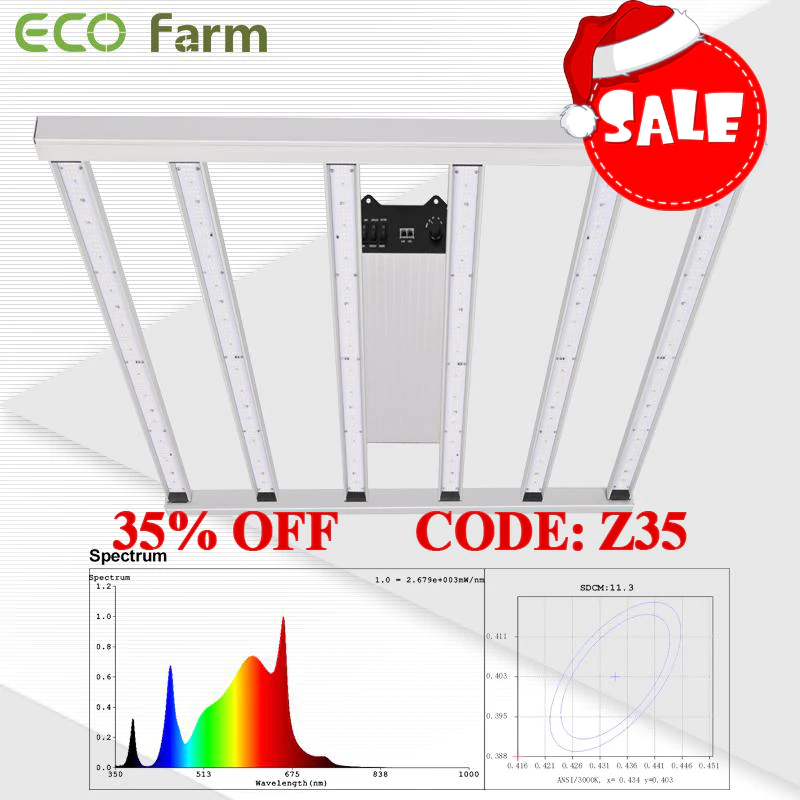
Features:
The PPE of the ECO Farm LED grow light is 2.7umol/J and the PPF is 1752umol/s, providing a high yield for light-loving plants. Energy saving and low heat compared to other types of grow lights. This is a LED grow light with 6 strips design, the light size expands to 4*4 feet. This will confirm evenly distributed coverage throughout the canopy, including the plant edges. Everbright coverage can reach 4*4~5*5 feet. The full spectrum is ideal for most light-loving plant seedlings, vegetation and the entire growth stage of flowering. IP65 waterproof horticultural lighting system can be used in humid or water vapour environments, easy to use, plug and play.
Hyphotonflux SMART-670W Full Spectrum LED Grow Light

Features:
Hyphotonflux LED Grow Light has a complete full spectrum of indoor plants from seeding to flowering, including white 6500k, deep red 660nm, uva 385nm, far red 730nm. SMART-670 built-in top compartment SAMSUNG & SEOUL diodes. It achieves an unrivaled efficacy of 3.03 μmol/J (UV off) and 2.69 μmol/J (UV on). The HYPHOTONFLUX SMART-670 is designed in a larger size (43.86"x43.66") to provide better PPFD coverage on 5'x5' flower grows and 6'x6' vegetable grows. Flexible 180°folding design, plug and play.
How to reduce the cost of plant growth lights
If you only grow a few houseplants, you may not even notice a difference in your electricity bill once you start using grow lights. But if you have a lot of plants or an indoor jungle like me :) then you can find ways to reduce your expenses.
Reduce the energy you consume by switching to more efficient, longer-lasting LED grow lights. A U.S. Department of Energy (DOE) report examining the energy-saving potential of LED lighting in horticultural applications found that LED grow lights can reduce electricity consumption by 24% to 30% compared to traditional lighting technologies. If you used incandescent lights, you can save money by switching to LED lights now.
Switch to a more affordable electric company. If there is more than one electricity provider in your country/state, check which one is more affordable and make a change.
Keep your grow lights on during the cheapest time of the day. If this possibility is available in your state/company, use grow lights during times of the day when prices are lower.
Reduce the number of hours your grow lights are on. Whether the new leaves are getting bigger or smaller, whether there are more or fewer windows. The reduced time will most likely be fine if the leaves continue to grow larger and open more windows. Your electricity bills will drop.
Use available natural light if possible. If the weather is sunny and your plants are near a window, you probably don’t need grow lights. In that case, turn them off, even if only for a few hours. You can even set them to turn off and on automatically using one of the timers.
Conclusion
Based on our reviews, we think the best grow lights are LED lighting. LED grow lights use artificial light to provide optimal plant growth.
ECO Farm ECOD Samsung UV+ IR 640W Dimmable LED Grow Light VS Hyphotonflux SMART-670W Full Spectrum LED Grow Light
June 06, 2023
Growing houseplants should be a breeze — after all, you don’t have to struggle with drought or frost. But you may have one big limiting factor: lack of quality sunlight. Fortunately, adding some grow lights to your houseplants can solve this problem, allowing plants to thrive even in darker corners of your home.
If you are wondering how to use grow lights for your houseplants, you are in the right place.
Benefits of Using Grow Lights
There are many benefits to using grow lights, including:
Increased Yield — Grow lights can help you get bigger and better yields by giving plants more light than they can get from natural sunlight alone.
BETTER QUALITY — Grow lights can also help you produce higher-quality buds by increasing the amount of light your plants receive. This results in denser buds and more trichomes (tiny crystals containing THC).
Faster Growth — Grow lights can help plants grow faster by providing them with more light than they would get from natural sunlight alone. This is especially beneficial if you are growing plants for medical purposes and need to harvest the crop as quickly as possible.
ECO Farm ECOD Samsung UV+ IR 640W Dimmable LED Grow Light

Features:
This ECO Farm LED Grow Light has high energy efficiency up to 40% energy saving, and get 50% greater yield compared with the traditional HPS lights. High quality and 50000 hours long lifespan can mostly reduce your electricity bills or maintenance fees.The bar structure LED grow light provide you more even and full canopy coverage, make the light more concentrated, make the illumination is more uniform. The growth of plants requires an environment of red and blue wavelengths, use led grow lamps to boost productivity, Increase your yields & profits 50% without adding any additional energy costs. This grow light dissipates heat quickly and high performance, growing lamp with 6 passive-cooled bars, no-fan no noise design, give you a quiet cultivation environment and extend plant light lifespan.
Hyphotonflux SMART-670W Full Spectrum LED Grow Light

Features:
Hyphotonflux LED Grow Light has a complete full spectrum of indoor plants from seeding to flowering, including white 6500k, deep red 660nm, uva 385nm, far red 730nm. SMART-670 built-in top compartment SAMSUNG & SEOUL diodes. It achieves an unrivaled efficacy of 3.03 μmol/J (UV off) and 2.69 μmol/J (UV on). The HYPHOTONFLUX SMART-670 is designed in a larger size (43.86"x43.66") to provide better PPFD coverage on 5'x5' flower grows and 6'x6' vegetable grows. Flexible 180°folding design, plug and play.
Factors to Consider When Choosing LED Grow Lights
When choosing LED grow lights, there are several factors to consider. First, of course, is the size of your grow tent. The size of your grow tent will determine the actual power output of the LEDs you need to ensure adequate coverage for your plants, and how many LEDs you need for your garden to be successful.
The next factor to consider is watts per square foot. This is important because higher wattage lights produce more lumens of light intensity per square foot. The result is that around 45–60 watts per square foot are needed to provide optimal coverage — too little wattage can result in insufficient coverage, while too much wattage can cause burns and create gaps between the light and dark times needed for health Unbalanced growth cycle.
LEDs have different spectral ratios — the colors that are mixed in the lighting spectrum according to the plant species — which allow growers to better control the growth cycle of the plants compared to the traditional wavelengths used in HPS lights. Different colored LEDs balance the lighting spectrum, full spectrum LEDs use all colors of light needed; white spectrum, blue spectrum and red spectrum to promote vegetative growth, flowering period or both depending on growth requirements.
Last but not least — power consumption and cooling systems are also an important part of any LED system as they help manage the heat generated by the lamp and determine how cooler temperatures in low humidity environments are maintained optimally levels to meet the needs of the plant for better overall health. Choose LEDs that use an efficient cooling system and reduce energy consumption without sacrificing brightness, so you can save on energy bills over time without compromising the quality of light it provides.
Conclusion
Following our guide, we hope you’ve found suitable LED grow lights. By considering factors such as plant type, growth stage, area of coverage, and intensity requirements, you can determine the proper wattage and coverage of the grow lights you need.
Also, regularly evaluate and adjust your lighting setup as your plants progress through different growth stages.
With the right lighting, you can create an ideal environment that promotes vigorous plant growth, high yields and horticultural success.
Thanks for reading!
ThinkGrow LED Model-H Plus 720W LED Grow Light VS ECO Farm ECO Z Lite 750W LED Grow Light
June 05, 2023
Grow lights are an important tool when plants need more light. Indoor plants that may not receive enough light from windows, especially in winter, can benefit and thrive from grow lights. They are often essential for most seeding operations. Even a bright window with plenty of sunlight may not be enough to give seedlings the best start. Grow lights can solve this problem.
Why Choose LED Grow Lights?
LEDs are known to consume less power and generate less heat than popular and inexpensive HID or fluorescent lamps.
But what you don’t know is that plants respond to LEDs during both the vegetative and flowering stages. Yes, plants love LED grow lights, they grow faster under these lights!
ThinkGrow LED Model-H Plus 720W LED Grow Light

Features:
The ThinkGrow LED Grow Light is a true 5' wide LED grow light designed for indoor grow rooms for high PPFD cultivation practices in vertical farming. There are 3368 high-efficiency top-bin diodes in the lamp, the total power is increased to 720 watts, and the performance is improved by 18%PPF. Four spectral channels, including UV, White (full spectrum), Crimson and Far Red, allow complete control to customize the desired spectrum/light recipe for your plants. The patented plug-and-play light bar design is also easy to install for future maintenance.
ECO Farm ECO Z Lite 750W LED Grow Light
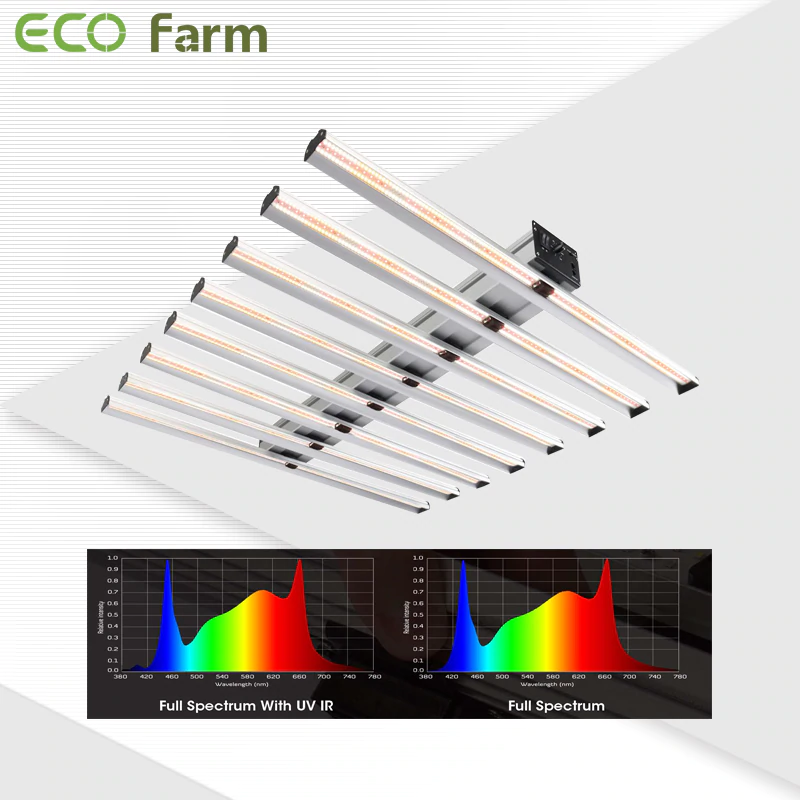
Features:
This ECO Farm LED grow light features an 8-bar design for more even and complete canopy coverage. Equipped with high efficiency diodes with extremely low thermal resistance. Grow lights are flicker-free and dim, with a lifespan of 50,000 hours. LED grow lights consume 750 watts at 2069 µmol/s for a satisfactory PPE of 2.8 µmol/J, ideal for 6 x 6 ft. plant areas or 5 x 5 ft. flowering areas. Each full spectrum LED grow light uses a custom made 2100 diodes. The abundance of wavelength types is consistent with the spectral range of plant photosynthesis. It concentrates specific wavelengths of light to illuminate crops evenly, controlling plant height and plant nutrients.
Things to consider when choosing the best LED grow lights
The grow lights are the artificially created light which provide a broad spectrum of light, replicating the natural source of light- sunlight. As there are so many brands and so many options of grow lights in the market, it is necessary to consider some specific factors.
Heat Generation
The heat generation is much different between the different lights for the flowering stage. This is very important as you need to consider two things. Firstly, excess heat can damage the plants or can reduce production. And secondly, excess heat can mean less light generation, which means the money spent is not worth it. The CFL lights produce the most heat among HID and LED lights. For all lights, as the price increases, the quality and heat production decrease.
Colour
Red and Blue are the most common and best-coloured lights for the growth of plants, however, red is the most appropriate colour for the flowering stage of a plant. Therefore, for the flowering stage, go for red-coloured lights or similar colours. For this stage, the colours between 620 nm to 780 mm are the most effective.
Lumens
Lumen is the unit for measuring the total light emitted from the light source from the visible spectrum. This is a critical factor as they help to determine the total amount of light the plants can absorb. The plants cannot grow effectively if the right amount of light is provided to them. The LED bulb is the best in lumens, followed by CFL.
Wattage
Watts or wattage is the unit to show the rate of the electrical power used by the light. Companies often describe the watts as the power capacity of the light. But, the light strength is not directly related to the function or wattage of the light. As higher wattage produces more heat, the light becomes less efficient.
Safety
Light safety is crucial as the safety of the light is more than just eye protection. There are two things that you need to consider while looking for light safety. Firstly, you need to consider how fragile the light is. And secondly, what are the components used for the construction of the light? In both areas, LED bulbs are the clear winners.
Conclusion
Plants, just like humans, need some vital things to survive, but making the most of what you need will only result in better quality. In other words, if you provide your plants with the best LED grow lights that cover every aspect of the lighting your plants need, your crops can and will be the best. We hope these top-rated grow lights help your indoor garden.
Every grow room is different, and some aspects of LED grow lights may not be perfect. By considering the variables of your grow room, plants, and soil, you can easily determine which LED grow light is right for you, and more specifically, your plants.
Spider Farmer G5000 480W Full Spectrum LED Grow Light VS ECO Farm ECOZ 510W Samsung 301H Chips LED Grow Light
June 02, 2023
Grow lights can be used to enhance the natural beauty of your interior with some of the best LED grow lights — the best choice for your indoor garden. Since the aesthetics of a plant and its growth depend on one’s preferences, there is a need to improve the growth of houseplants. They are popular and inexpensive devices that can provide your houseplants with a unique atmosphere while also aiding in their physiological growth.
Different lighting in indoor gardens is essential for the growth of plants. In the next article, we’ll take a look at some of the best grow light options, their features, effectiveness, and how they can be ideal for growing plants.
Are grow lights good for houseplants?
Growing houseplants is an enjoyable and fulfilling experience. However, not all indoor environments are suitable for plants to thrive. Natural light is essential for plant growth, but in some cases it may not be enough. This is where grow lights come in. Grow lights are artificial light sources designed to provide plants with the light they need for photosynthesis. But are they good for houseplants? In this blog post, we’ll explore three reasons why grow lights are good for houseplants.
1. Fill light
One of the main reasons grow lights are beneficial for houseplants is that they provide supplemental light. As mentioned earlier, natural light may not be enough for plants to thrive indoors. This is especially true in winter when the days are shorter and the sun less intense. By using grow lights, you can supplement natural light and ensure your plants have enough light to grow and thrive.
2. Customizable spectra
Another advantage of grow lights is that they offer a customizable spectrum. Different plants have different light requirements. For example, flowering plants need more red light, while foliage plants need more blue light. With grow lights, you can customize the light spectrum to meet the specific needs of your plants. This means you can give plants the exact type of light they need to grow and thrive.
3. Annual growth
Finally, grow lights are great for houseplants because they can be grown year-round. In many parts of the world, the harsh winters make outdoor gardening impossible. By using grow lights, you can grow plants indoors all year round. This means you can enjoy fresh herbs, vegetables and flowers even when it’s cold and dark outside.
In conclusion, grow lights are beneficial for houseplants for several reasons. They provide supplemental light, offer a customizable spectrum, and allow year-round growth. Whether you’re an experienced gardener or a beginner, grow lights can help you create a thriving indoor garden. So if you’re looking to bring some greenery into your home, consider investing in some grow lights to help your plants grow and thrive.
Spider Farmer G5000 480W Full Spectrum LED Grow Light
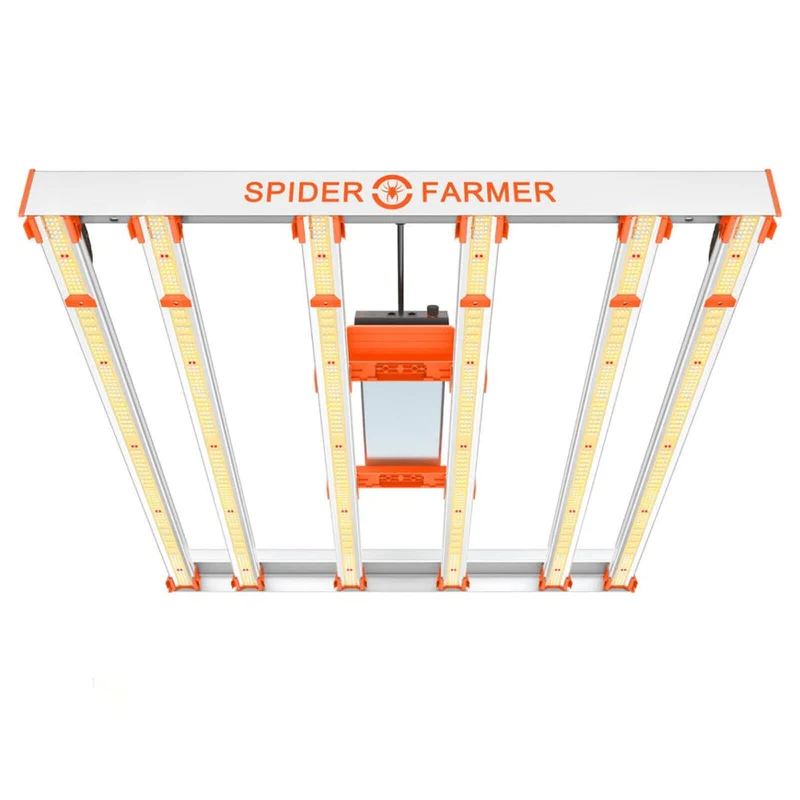
Features:
Spider Farmer led grow light has a unique elongated light bar design, which provides more even and comprehensive canopy coverage. Equipped with 1680 high-efficiency diodes, the G5000 LED grow light delivers 480 watts, achieving an impressive 2.8 umol/J PPE, covering a highly productive full-cycle grow of 4x4 feet. The G5000 Grow Light is a full-spectrum LED grow light (660–665nm, 3200–4200K, 4800–5000K) with different wavelengths of light, perfect for every stage of plant growth. The dimming button can adjust the brightness of the light, 10–100% dimming to meet the needs of plant growth.
ECO Farm ECOZ 510W Samsung 301H Chips LED Grow Light With Separately UV+IR Control
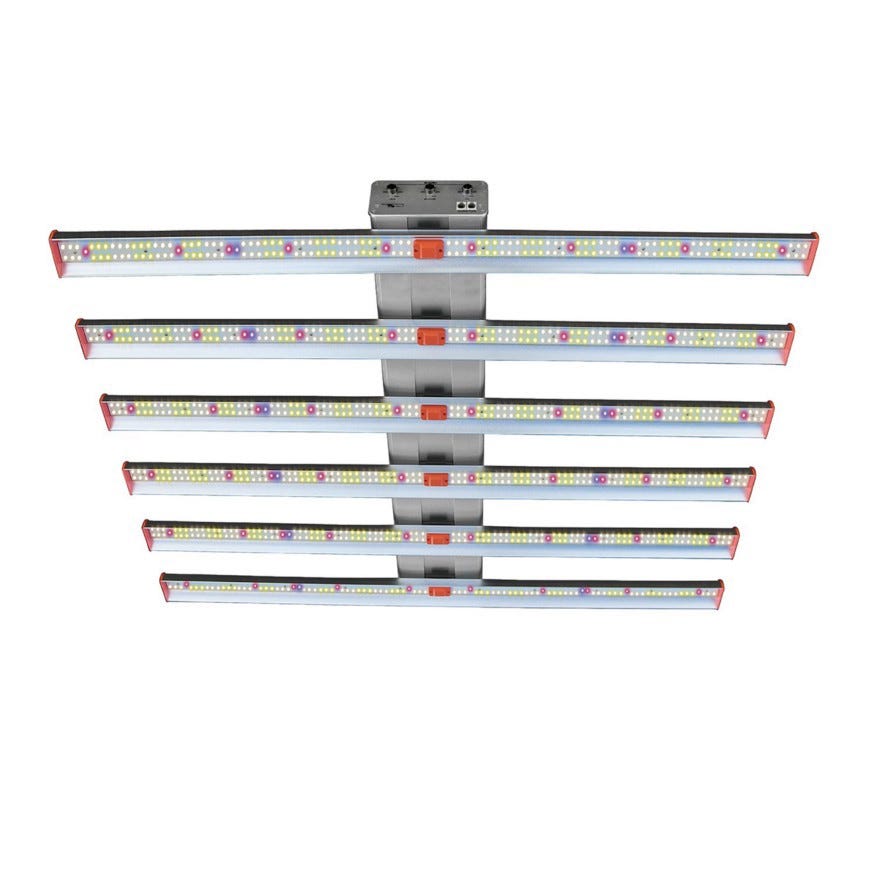
Features:
The ECO Farm grow light is Built with the best parts, Top Bing Samsung LM301H & Osam Chip and brand driver for higher efficacy and longer lifespan; to ensure high-efficiency PPE 2.75umol/J, better heat dissipation, and long service life. Compared with old plant lights, the average PPFD is increased by 30%, and the yield and quality are increased by 50%. With 6 LED growth lights, each rod is covered with high-grade glue, waterproof, and easy to clean, not easy to be filled with dust. This plant growth light also uses a special dimmer, which can precisely adjust the brightness. 0–10 levels are optional. This means that you can see clear brightness levels and record while adjusting. No need to worry about differences. Full-Cycle Sunlike Spectrum, close to natural sunlight. The spectrum applies to the entire stage of indoor planting.
Buying Guide
Spectrum/Uniformity
An even spectrum is the hallmark of the best LED grow lights, so even if you have four plants under the same light, they will all receive the same spectrum.
We’ve spent some time discussing the spectrum, but it’s worth reiterating that the ideal spectrum includes not only visible red and blue light, but also infrared (IR) and ultraviolet (UV) radiation (UV).
When using full-spectrum LEDs, you can go from seed to harvest with a single light source without turning off bulbs or investing in separate grow lights for vegetables and flowers.
Strength
The more light the LEDs produce, the better the crop will grow (in most cases). Therefore, the most effective LED grow lights need to have a lot of sap.
Efficiency
The vast majority of LED grow lights are very efficient. However, the most effective LED grow lights are also the best. It is critical that the system perform at a high level, generate large amounts of power, and reduce operating costs.
Reliability/Durability
LED grow lights are an investment because of their hefty price tag. Your investment needs to have a long life if it is to provide profit.
That’s why the best LED grow lights have proven to be so reliable and long-lasting.
Light Direction
Unlike many other types of lighting, LEDs are small enough to easily mount on walls or other flat surfaces. In other words, LED grow lights are very flexible and can be pointed in any direction. Many other types of bulbs radiate light in all directions. Because LEDs are small, they emit a direct beam of light in a predetermined direction. Instead of scattering light from ceilings and walls, it focuses it precisely where it can do its best.
Longevity
Nothing frustrates me more than walking into a room, flipping a switch, only to find out that the light bulb is out. Since the lights are only on when it’s dark, this troublesome problem continues when it’s most inconvenient — at night, when the hardware store is closed. Countless times I’ve lost a foot by stepping on something sharp.
However, with the advent of LEDs, this may become a thing of the past, or at least not happen as often. In most cases, LEDs are praised for being extremely durable. A single LED bulb lasts around 40 times longer than a traditional incandescent bulb. Fluorescent bulbs, on the other r hand, need to be replaced six times less often than typical LED bulbs.
Conclusion
In summary, finding the best LED grow lights for indoor growing is critical to achieving high yields and healthy plants.
It’s important to note that every grower’s needs are different, and factors such as space size, plant type, and budget must be considered before making a purchase. By considering these factors and researching different options, growers can find the perfect LED grow light to meet their specific needs and achieve the best results.
Spider Farmer G5000 480W Full Spectrum LED Grow Light VS BESTVA BAT W400 Dimmable LED Grow Light
May 30, 2023
There are a variety of grow lights for growing plants on the market, each with its own unique advantages and disadvantages. In general, however, grow lights can be roughly divided into two main types: HID (High Intensity Discharge) and LED (Light Emitting Diode).
HID grow lights are generally more powerful and emit more heat than LED lights, making them ideal for larger grow jobs. However, they also require more energy to run and generate more heat, which can be a problem in smaller grow spaces.
LED grow lights are becoming more and more popular due to their energy efficiency and low heat output. While they may not be as powerful as HID lights, they can still produce great results and are a great choice for smaller grow spaces.
Some LED lights are full-spectrum, which means they mimic the sun in the light they produce. There are also options that produce higher UV/IR ratios, which tend to speed up the growth process and increase yields.
No matter which grow light you choose, it’s important to make sure it’s installed and positioned correctly for best results. If you’re growing plants indoors, you’ll also want to invest in a good ventilation system to help remove excess heat and humidity.
Do I need LED grow lights?
It is impossible to grow plants indoors without lights. If you plan to grow in a controlled environment, the simple answer is yes — you need grow lights. All plants require energy in the form of photons for photosynthesis. Your plants can survive indoors using ambient light from household light sources and windows, but it will have zero productivity.
While it is technically possible to grow plants using standard bulbs, it is not recommended. The light they produce is limited in range, spectrum and intensity. They also generate a lot of heat, consume more electricity, and have a shorter lifespan than grow lights.
Household bulbs are not designed for plants. Adequate lighting solutions for your crops are essential if you want to achieve high yields.
Spider Farmer G5000 480W Full Spectrum LED Grow Light

Features:
Spider Farmer G5000 led grow light has a unique elongated light bar design, which provides more even and comprehensive canopy coverage. Equipped with 1680 high-efficiency diodes, the G5000 LED grow light delivers 480 watts, achieving an impressive 2.8 umol/J PPE, covering a highly productive full-cycle grow of 4x4 feet. The G5000 Grow Light is a full-spectrum LED grow light (660–665nm, 3200–4200K, 4800–5000K) with different wavelengths of light, perfect for every stage of plant growth. The dimming button can adjust the brightness of the light, 10–100% dimming to meet the needs of plant growth.
BESTVA BAT W400 Dimmable LED Grow Light
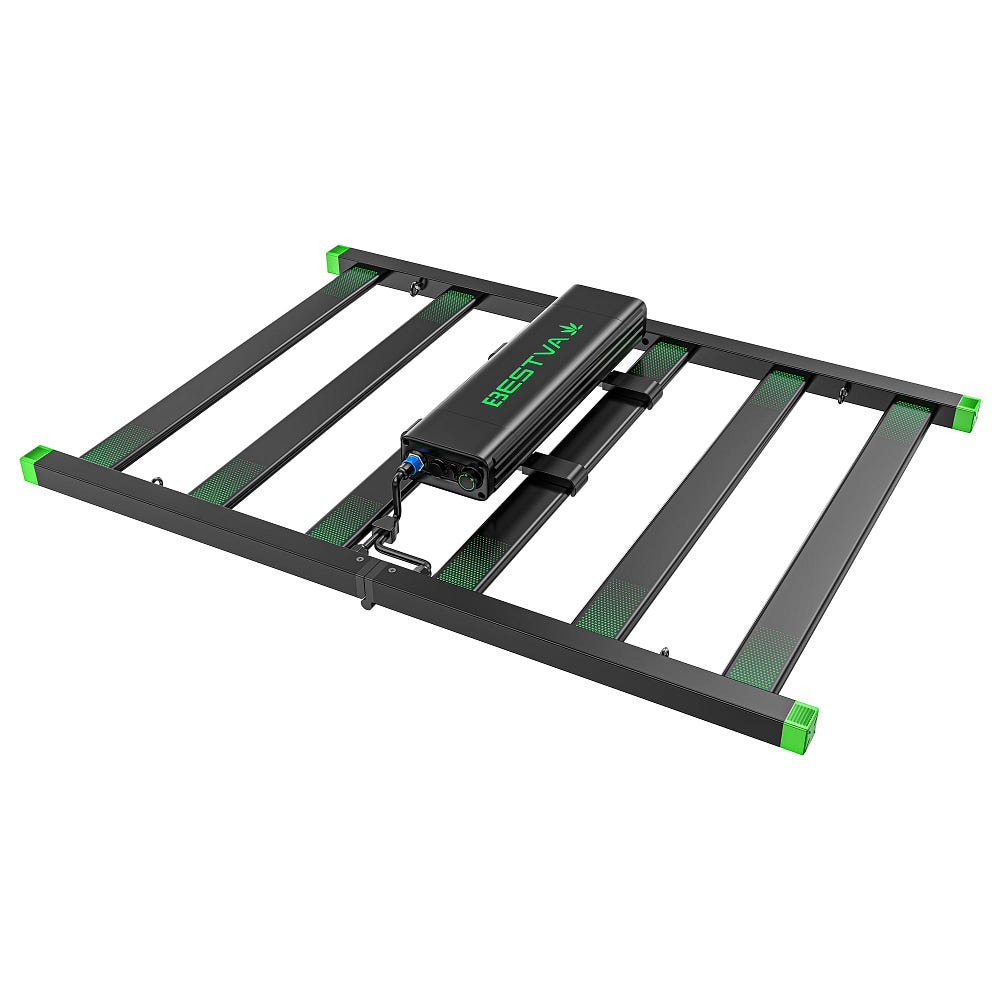
Features:
The BESTVA LED grow light is the solution for indoor growing environments where ceiling height and distance from the tree canopy are critical. The BAT W400 is ideal for use in vertical racks, low rooms, benches and even tents. The grow light provides an efficient full spectrum and a healthy red-blue ratio to drive photo composition. Light energy between 500–599nm, previously thought to be wasted, penetrates deep into the plant canopy and promotes photomorphogenic responses. High colour rendering “white” light helps quickly identify potential threats to crops and provides superior working conditions and safety for workers. It is great for flowering and plant production.
Considerations When Choosing Grow Lights
When it comes to grow lights, there are three main factors to consider: the color of the light, the energy cost of the fixture, and the intensity of the light. Before we compare LED lights vs. fluorescent lights, let’s understand the needs of plants.
Light Color
We all know that plants need light to thrive, but have you ever wondered how the shade of light affects plant growth?
The sun produces the full visible spectrum, including red, orange, yellow, green, blue, indigo, and violet. This is known as full spectrum or white light.
Most houseplants thrive in full-spectrum bulbs, which produce a balance of warm and cool light that mimics (or at least tries to mirror) the sun. Seedlings, houseplants, culinary herbs, and a variety of other plants thrive in this full-spectrum light.
In general, blue light promotes leaf and stem development. Red light promotes flower development, making it essential for fruiting plants. However, there is a wealth of information available regarding the unique advantages of red and blue light. Some of them are also deceptive.
Par and Lumens
It’s easy to overlook the fact that plants and humans receive light in completely different ways. Humans use photopic vision to perceive color. Photosynthetically Active Radiation (PAR) is the wavelength of light that drives photosynthesis in plants. An excellent article on the difference between PAR and lumens can be found here.
PPF (Photosynthetic Photon Flux) refers to the total amount of light produced per second by an LED, fluorescent lamp or other light source. This is what we call the intensity of the grow light. The unit of measurement is micromoles per second (umol/s).
What is the PAR value of the lamp?
The wavelength of light that stimulates photosynthesis in plants is PAR (Photosynthetically Active Radiation). We use the photosynthetic photon flux to calculate the amount of PAR produced by the system per second (PPF). PPF doesn’t indicate how much measured light reaches the plants, but it’s a must-know if you want to determine how efficiently your lighting system is producing PAR.
Conclusion
Now that the topic of the best lights for indoor growing has been shed light, get out there and start your adventure.
If you have an indoor growing facility, you need lights. Whether you choose CFL, HID or LED depends entirely on your space, pressure and of course your budget.
ECO Farm ECO Z Lite 750W LED Grow Light VS Iluminar HyperMol 720W LED Grow Light
May 25, 2023
Do you live in an apartment without much natural light, or in a house facing east? If so, don’t worry, you don’t have to settle for low-light plants or give up indoor gardening entirely. All you need is a grow light. While many grow lights prioritize function over design, there are also options that masquerade as home lighting, and they can expand your decor while keeping your plants happy.
LED Grow Light Color Type
Not all spectral colors support plant growth.
Below are the primary colors and their specific contributions to plant growth.
Red: This light color has a wavelength of 600–700 nm and supports the overall growth of the plant with a special focus on promoting fruiting and flowering.
In addition, this color regulates plant hormones and stimulates the production of chlorophyll for photosynthesis.
Blue: This light exhibits a wavelength of 400–500 nm and supports root development, leaf formation and general vegetation growth.
Green: Although green is not as important to plant growth as the above two, it still has a certain effect on plant growth.
This light color has a wavelength of 500–600 nm and helps promote plant health.
Far Red Light: This light color is closely related to red and has a wavelength of 700–800 nanometers.
Together with red light, they affect photomorphogenesis and support overall growth.
ECO Farm ECO Z Lite 750W LED Grow Light
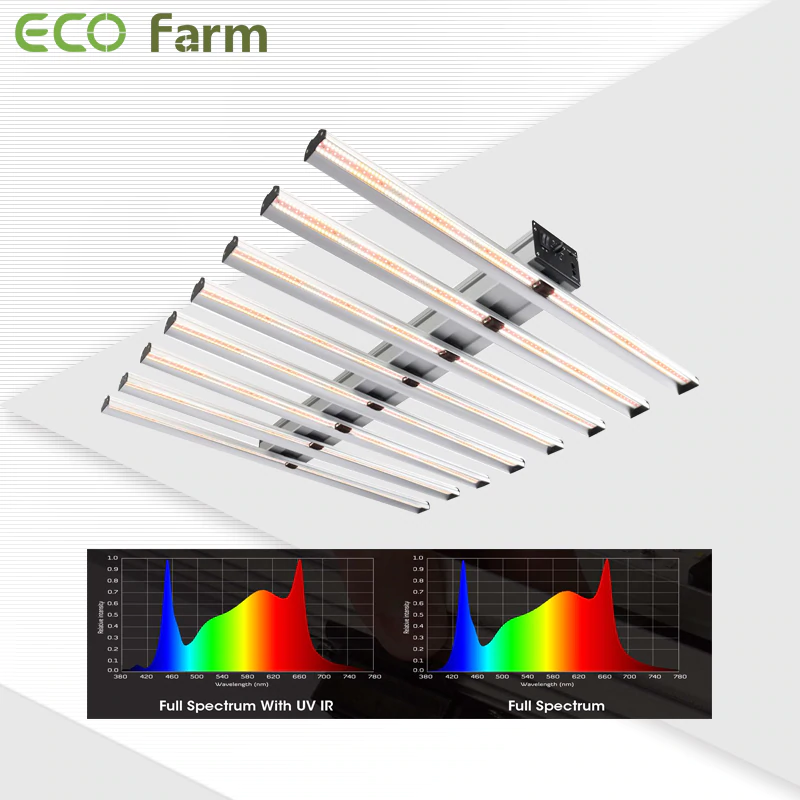
Features:
This ECO Farm LED grow light features an 8-bar design for more even and complete canopy coverage. Equipped with high efficiency diodes with extremely low thermal resistance. Grow lights are flicker-free and dim, with a lifespan of 50,000 hours. LED grow lights consume 750 watts at 2069 µmol/s for a satisfactory PPE of 2.8 µmol/J, ideal for 6 x 6 ft. plant areas or 5 x 5 ft. flowering areas. Each full spectrum LED grow light uses a custom made 2100 diodes. The abundance of wavelength types is consistent with the spectral range of plant photosynthesis. It concentrates specific wavelengths of light to illuminate crops evenly, controlling plant height and plant nutrients.
Iluminar HyperMol 720W LED Grow Light

Features:
Iluminar LED Grow Light is a plug and play high performance LED grow light. Advanced SMD chips are used with non-adhesive potting to ensure longer life and better durability. The unique diode layout provides a uniform 4' x 4' footprint with a minimum of 8–12 inches from the canopy. More fins allow for quiet and efficient cooling.
What to Look for When Buying LED Grow Lights
There are many factors to consider when choosing LED grow lights.
Light Intensity and Spectrum
Each stage of plant growth requires a different type of LED grow light. LED grow lights are classified according to their use for vegetation and flowering. If you’re growing herbs or any other leafy plants, you don’t need to buy LED grow lights with a spectrum designed for flowering.
When growing crops or other plants, you need a flowering spectrum. Therefore, your growing space must be equipped with vegetation and flowering LED grow lights. Grow lights provide a full spectrum to meet the needs of plants in both stages of development.
Durability and Build Quality
LED grow lights typically have a lifespan of 50,000 hours or more, while HID bulbs typically have a lifespan of 10,000 to 18,000 hours. So, make sure that the LED grow lights you are buying are durable and high quality.
Energy Efficiency
With high-quality LED light fixtures, you can be sure your plants will thrive and your electricity bills won’t go up. Possibly the best LED grow light installations are energy efficient and consume 50% less energy than older indoor lighting technologies like high pressure sodium (HPS).
Cooling
In some cases, LED package heat losses can vary by as much as 20% between different manufacturers, depending on the conversion technology.
Coverage Area
Most of the best LED grow lights measure the coverage they provide for plant growth and flowering. When you plan to grow plants indoors or in plants, it’s important to choose lights that match the amount of light and type of coverage you need.
Conclusion
Choosing the right LED grow lights is a critical decision that can greatly affect the productivity and success of your indoor garden. Understanding your plants’ lighting requirements, exploring the different types of grow lights available, and considering key factors such as light intensity, color spectrum, energy efficiency, and durability will guide you in making an informed choice.
By implementing proper positioning, scheduling, monitoring and maintenance practices, you can create an optimal environment that maximizes productivity and supports the healthy growth of houseplants
